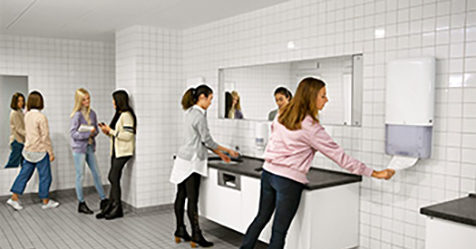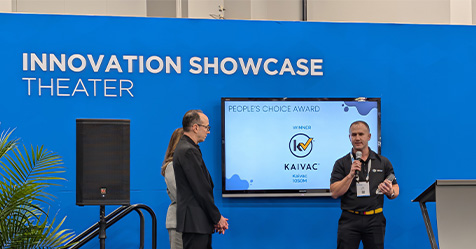Have you ever gone into a public restroom and heard someone in the next stall having what sounds like a conference call with a dozen people?
Expect those “conference calls” along with 20-minute “beautifying” sessions in public restrooms to be things of the past in the post-COVID-19 era.
“Public restrooms are no longer the place to use your phone, do your hair and makeup, [or] that sort of stuff,” Elizabeth Scott, an associate professor of biology at Simmons University in Boston and founder of the Simmons Center for Hygiene and Health in Home and Community, says in a recent article in New Jersey’s The Daily Journal. “You [will] want to get in and out of there as fast as possible.”
This is just one of several changes we can expect. Along with modifications in the ways restrooms are cleaned and sanitized, we can anticipate major structural redesigns as well.
Some of these shifts are long overdue. For instance, have you ever opened a restroom door to find a line of people inside waiting to use the facility? Consider that another condition of the past. More restrooms will be designed with availability indicators. As one person leaves, a light installed outside the restroom will turn from red to green to indicate the next patron may enter.
Further, restroom users may no longer come in and leave through the same door. Especially in larger restrooms, you can soon expect two automatic doors—one for entry and one for exit. This not only will help regulate occupancy, but will also reduce the number of surfaces touched. More restrooms will also have s-shaped doorless entries, such as those in airports and other heavily used facilities.
Protection from the plume
Of interest to cleaning professionals, restroom design will include features to deal with toilet plume—aerosolized droplets of water that spread germs.
“Plume, whether from toilets or urinals, is caused when they are flushed,” says Klaus Reichardt, CEO and founder of Waterless Co. Inc. “They release germ-infected particulates that invariably land on nearby surfaces, but which can also be inhaled.”
The problem may be worse with urinals as plume can also be released through splatter when the urinal is being used. According to Reichardt, cleaning professionals have known about plume for years but it is of greater concern today because recent studies have reported traces of the novel coronavirus in urine and solid waste.
“If these particulates are inhaled or touched when they land on surfaces, cross-contamination can begin, causing the spread of the disease,” he says.
To address this situation, more facilities are likely to consider installing no-water urinals. No water means no splatter and no flushing, which means no plume.
As for toilets, we may see the comeback of the toilet lid. These were removed decades ago in commercial facilities because they added to the cost of the toilet and were one more thing to clean. However, lids can play a key role in controlling plume by blocking its release or minimizing the particles that become airborne.
Social distancing
Along with the loss of toilet lids, many restrooms no longer have partitions between urinals. Most likely the reasons for this are similar to why toilet lids disappeared; partitions require the added cost of installation and increase the number of surfaces that must be cleaned.
But in the post COVID-19 restroom, keeping a six-foot distance between restroom patrons is ideal. The simplest way to accomplish this is to put more space between urinals and to install partitions—or longer partitions—between urinals. We can expect to find these solutions implemented in men’s restrooms moving ahead.
Enhanced ventilation
After the 2002-2003 outbreak of SARS in Hong Kong, studies indicated that poor ventilation played a role in exacerbating the spread of the disease. It is believed the same may be true with COVID-19. Joe Allen, director of Harvard’s Healthy Buildings Program, says in a recent article on nationalgeographic.com, “I always remind people to check the exhaust in the bathroom.” He added that moving “dirty” air out of the restroom is one of the best ways to safeguard against contamination.
Gender-neutral options
Gender-neutral restrooms were the talk of the restroom industry about two decades ago. Several avant-garde hotels and commercial properties wanted to be the first to install them. However, they never really took off.
But COVID-19 may have turned things around. With a gender-neutral restroom, toilets are housed in individual stalls. These are often floor-to-ceiling, fully enclosed partitions with walls—no open spaces below or above. Sinks are available in a common area.
A totally enclosed stall offers privacy and safety, as well as social distancing. Steven Soifer, president and cofounder of the American Restroom Association, has long advocated for the installation of “single-person, gender-neutral restrooms.” However, this may be a costly option.
The journey continues
We can expect more changes in the post-COVID restroom. “This really is becoming a journey,” says Reichardt. “Even when COVID is no longer an issue, it will have caused many restroom manufacturers to reconsider how restrooms are used and how they can be redesigned to further promote health and safety.”




